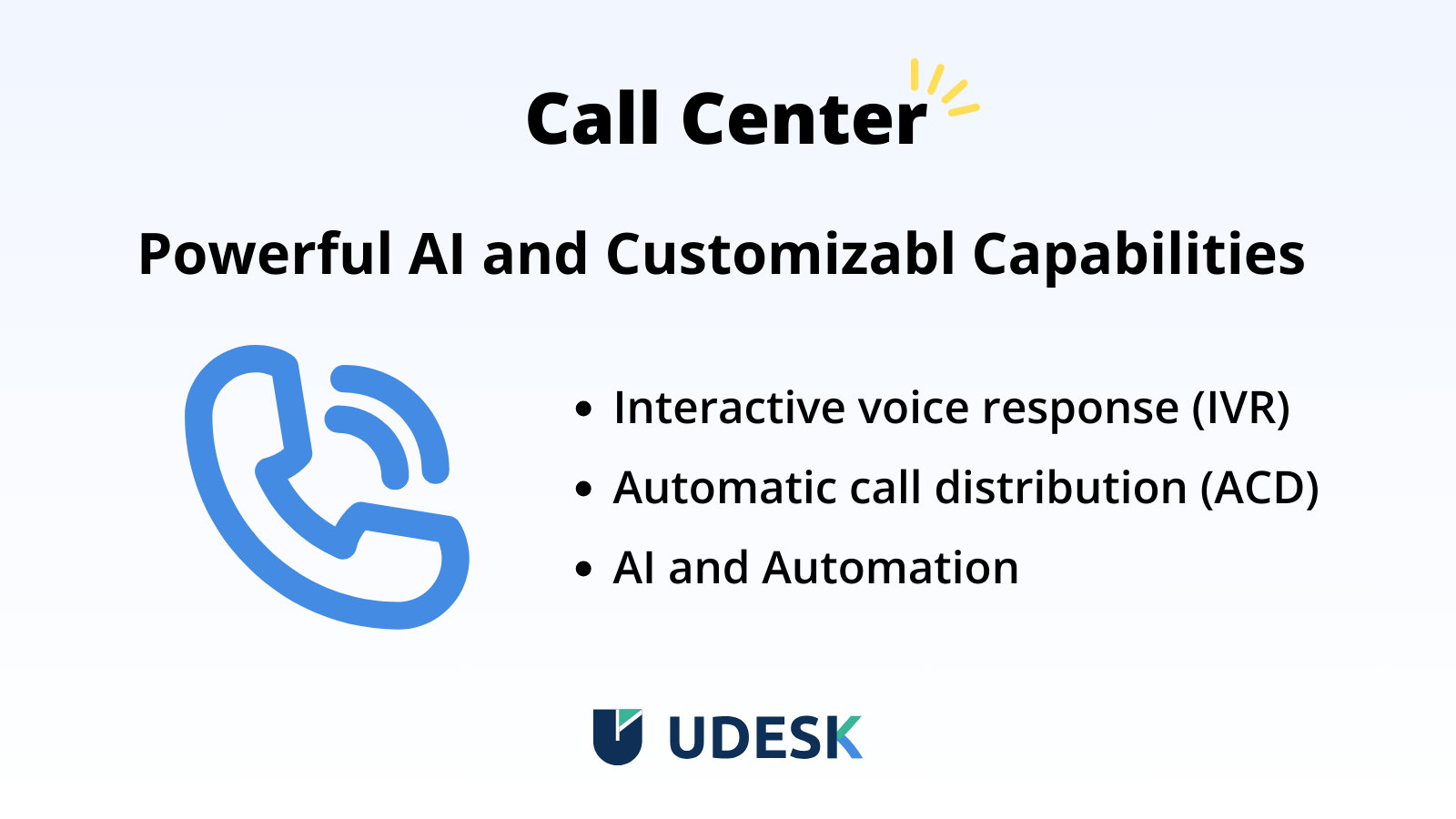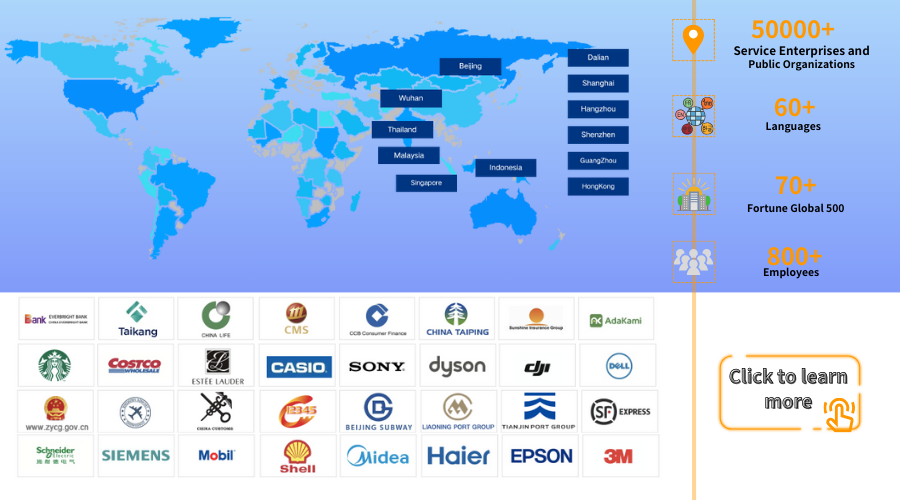Call Center 101: Definition, types, and how they work
Article Summary:In this article, we’ll provide you with all the information you need to know about call centers.
Table of contents for this article
- What is a call center?
- Benefits of call centers
- Examples of call centers
- So, how exactly does a call center work?
- 1. Customer makes a call
- 2. Customer interacts with an interactive voice response system
- 3. Customer service rep identifies the customer
- 4. Customer service rep resolves the issue
- 5. Customer service rep records the interaction and follows up
- Types of call centers
- What call center technology will I work with?
- Intelligent call routing
- Omnichannel agent desktop
- Workforce Management Solutions
- Self-service options
- Analytics
- Set up Your Intelligent Call Center with Udesk
You may picture a call center as a packed warehouse with small desks where weary agents constantly switch from one call to the next. While this stereotype still exists in some cases, it’s fortunately becoming less common today.
![]()
Modern call centers offer a much improved working environment. Many companies are recognizing that enhanced customer service training and improved job satisfaction play a significant role in reducing call center burnout and boosting customer retention and satisfaction.
In this article, we’ll provide you with all the information you need to know about call centers:
What is a call center?
A call center consists of customer service agents who handle phone inquiries from customers regarding a company’s services or products.
Many call centers prioritize customer satisfaction and provide extensive support. Some also focus on increasing lead generation, acquiring new customers, or streamlining payment and order processing.
In any case, call centers play a crucial role in delivering a positive customer experience, requiring them to maintain a high level of service to nurture relationships. Thus, call center representatives must be knowledgeable, patient, and helpful when interacting with customers.
It’s important to note that a call center differs from a contact center, as the latter manages customer communications across various channels, such as email, chat, messaging apps, or social media.
Benefits of call centers
There are many advantages that call centers provide for businesses, including enhanced customer service. Explore the other benefits below:
- Offer flexibility to employees: Numerous call center workers operate from home and gain from improved training. They are not limited to phone calls only — agents can utilize advanced call center software to interact with customers through other channels.
- Save money: Hiring a call center to monitor communications around the clock can be much cheaper than hiring one person to do the same job.
- Boost customer satisfaction: When a business has a reliable call center, customers will have a smoother experience, resulting in higher satisfaction and brand loyalty.
- Enhance your competitive advantage: A 24/7 call center can give you an edge over a company that doesn’t. A customer is more likely to stick with a brand known for a responsive customer service call center that provides helpful information quickly.
Examples of call centers
Here are some examples of call centers being used in different types of industries:
- Retail: Consumers can take advantage of retail call centers to ask whether a product is available, request a refund, get shipping details, and more.
- Healthcare: Healthcare call centers allow patients to change or confirm appointments, ask questions, and request prescription refills.
- Airlines: Customers can contact airline call centers to receive updates on their flight statuses, flight details, check-in information, and weather conditions for their destinations.
- Automotive: utilizes call centers to provide operational value to customers and increase the likelihood they will return.
- Government sectors: such as motor vehicle bureaus, local, state, and federal offices, police stations, prisons, public libraries, and unemployment insurance agencies would also greatly benefit from call center services.
How do call centers work?
So, how exactly does a call center work?
It may seem like a simple process, but successful call centers incorporate several factors into their customer service strategy.
1. Customer makes a call
The interaction starts when a customer contacts your business. They can call the call center or use a connected app or product.
2. Customer interacts with an interactive voice response system
After the customer contacts the call center, they are prompted by interactive voice response (IVR). This system greets callers with a menu of options and instructs them to make a selection using their voice or their phone’s touch-tone pad. An IVR can:
- Route customers to the right agent or department.
- Provide recorded responses to frequently asked questions.
- Deflect calls by allowing callers to switch from a live call to a text message.
- With IVR, the customer can also request a call back if there’s a long wait time.
3. Customer service rep identifies the customer
Once the customer is directed to the correct agent, the rep identifies the customer before solving their issue. Call center software provides customer context for faster problem resolution.
4. Customer service rep resolves the issue
The rep then deals with the request or issue, following call center etiquette to make customers feel valued.
5. Customer service rep records the interaction and follows up
Sometimes, a customer service rep cannot solve a problem in one call. In that case, they will need to create a ticket to follow up the customer’s problems.
If the issue is resolved on the first call, the support agent should send a customer satisfaction survey to gather feedback on the quality of customer service.
The agent can also ensure that the call information is stored in a CRM platform for future reference.
Types of call centers
Call centers today cater to a range of customer and company needs. They can be inbound or outbound, in-house or outsourced, proactive or reactive, or a mix of these options.
Inbound centers handle incoming calls from existing customers, addressing various services such as customer queries, technical support, and payments.
Outbound centers, on the other hand, reach out to both potential and existing customers, primarily for sales, telemarketing, fundraising, and market research.
Automated call centers use computer-based systems to handle caller responsibilities, reducing the need for human management.
Virtual call centers operate in remote locations and are cost-effective, allowing employees to work from anywhere.
Omnichannel call centers connect interactions across multiple channels and store caller information within the cloud.
Reactive call centers address problems as they arise, while proactive call centers engage with customers before issues occur, focusing on upselling, cross-selling, and identifying at-risk customers.
What call center technology will I work with?
Beyond the essential tools — a headset, computer, and Internet connection — you will probably utilize advanced call center software such as Udesk. Call routing, agent desktops, learning management systems, and other tools all contribute to making the work of agents and managers easier and more satisfying.
Moreover, call center technology can be integrated with your current tools. The Udesk API can be used with different third-party systems to assist with quality assurance.

Intelligent call routing
With intelligent call routing, inquiries are automatically directed to the right agents depending on their skills, channel, availability, or all three. Udesk’s implement automatic call distribution (ACD) with skills-based and intelligent routing to ensure every customer receives the right support.
Omnichannel agent desktop
An omnichannel agent desktop is an interface that provides a complete view of a customer’s history and interactions across all communication channels. It gives agents the context needed to provide the best possible customer experience.
Workforce Management Solutions
With Udesk, managers can use workforce management systems to automatically create schedules, arrange employee training& exams, conduct performance assessments, and most importantly, monitor agent activity in real time, track contact volume and quality. This software can integrate with the central dashboard or stand-alone.
Self-service options
IVR systems, knowledge bases, community forums, AI chatbots, and other automation tools help customers help themselves. When customers can solve basic problems on their own, agents and managers can focus on helping other callers with more complex or urgent needs.
Analytics
Udesk empowers your teams with user-friendly analytics and reporting tools, unlocking valuable insights for customer experiences improving.
With Udesk, you can stablish interactive dashboards to monitor real-time performance across of team members, and generate tailor-made reports, making data-driven decisions using actionable insights.
Set up Your Intelligent Call Center with Udesk
Ready to take the next step?
Take our Call Center for a spin—for free—to see how it can work for your business.
The article is original by Udesk, and when reprinted, the source must be indicated:https://www.udeskglobal.com/blog/call-center-101-definition-types-and-how-they-work.html
Call CenterCloud Call CenterContact Center

 Customer Service& Support Blog
Customer Service& Support Blog



